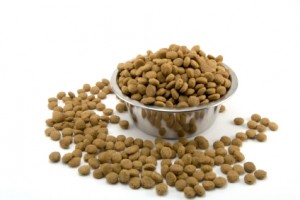 Of course you want to make the best decisions for your family members, including decisions regarding your canine companion’s diet. Hopefully, the following information will help you to select a quality dog food and assist you in your decision-making efforts.
Of course you want to make the best decisions for your family members, including decisions regarding your canine companion’s diet. Hopefully, the following information will help you to select a quality dog food and assist you in your decision-making efforts.
Thank you to Sarah Irick for giving her permission to publish the method she developed for grading dog food. Read about Sarah below.
Start with a grade of 100 points
- For every listing of “by-product”, subtract 10 points
- For every non-specific animal source (“meat” or “poultry”, meat, meal or fat) reference, subtract 10 points
- If the food contains BHA, BHT, or ethoxyquin, subtract 10 points
- For every grain “mill run” or non-specific grain source, subtract 5 points
- If the same grain ingredient is used 2 or more times in the first five ingredients (i.e. “ground brown rice”, “brewer’s rice”, “rice flour” are all the same grain), subtract 5 points
- If the protein sources are not meat meal and there are less than 2 meats in the top 3 ingredients, subtract 3 points
- If it contains any artificial colorants, subtract 3 points
- If it contains ground corn or whole grain corn, subtract 3 points
- If corn is listed in the top 5 ingredients, subtract 2 more points
- If the food contains any animal fat other than fish oil, subtract 2 points
- If lamb is the only animal protein source (unless your dog is allergic to other protein sources), subtract 2 points
- If it contains soy or soybeans, subtract 2 points
- If it contains wheat (unless you know that your dog isn’t allergic to wheat), subtract 2 points
- If it contains beef (unless you know that your dog isn’t allergic to beef), subtract 1 point
- If it contains salt, subtract 1 point
Extra Credit
- If any of the meat sources are organic, add 5 points
- If the food is endorsed by any major breed group or nutritionist, add 5 points
- If the food is baked not extruded, add 5 points
- If the food contains probiotics, add 3 points
- If the food contains fruit, add 3 points
- If the food contains vegetables (NOT corn or other grains), add 3 points
- If the animal sources are hormone-free and antibiotic-free, add 2 points
- If the food contains barley, add 2 points
- If the food contains flax seed oil (not just the seeds), add 2 points
- If the food contains oats or oatmeal, add 1 point
- If the food contains sunflower oil, add 1 point
- For every different specific animal protein source (other than the first one; count “chicken” and “chicken meal” as only one protein source, but “chicken” and “fish” as 2 different sources), add 1 point
- If it contains glucosamine and chondroitin, add 1 point
- If the vegetables have been tested for pesticides and are pesticide-free, add 1 point
Total Points = Grade
- 94 – 100+ = A
- 86 – 93 = B
- 78 – 85 = C
- 70 – 77 = D
- < = 69 = F
About Sarah Irick
My name is Sarah Irick and I am a Great Dane owner and rescue volunteer. I am a Civil/Industrial Engineer, not a veterinarian or animal nutritionist by education or employment. I do not work for a pet food manufacturer nor am I affiliated with one. I am just an individual who is concerned about what I feed my dogs and wants to help others decide what to feed their own. I cannot remember the exact date I designed this system, though I know it’s been more than a year (probably 2-3 years ago). I was concerned with the way people sometimes throw out names of “good” dog foods that maybe aren’t so good, and others take their words for it. Foods that maybe used to be good before their ingredients were changed for the worse or before better options became available are still being touted by some as being super-premium and I disagree. Since many pet owners do not have the time or inclination to do as many hours of esearch into pet (specifically dog)nutrition as I and many of you have, I wanted an *easier* way for them to compare labels. Unfortunately it is still a bit cumbersome (sometimes 2 people calculate the same food and get different scores even) but it’s better than nothing in my pinion.
Is it exact science? No. I don’t claim for it to be. In fact I’ve had to make a couple of changes over time (which the above don’t reflect) for new circumstances I’ve run across, such as the food that contained NO MEAT (not a special diet just one that was so cheap it didn’t contain any meat at all) and needs a steep penalty in my opinion, but still scored a decent grade on the original. Another example is the newer kibbles that contain no grain but, in my opinion, if it still has sufficient fiber and carbs then it deserves extra credit that wasn’t previously reflected. Also I’ve gotten comments and opinions that I take seriously and incorporate if it seems appropriate.
I don’t have a permanent site host for this although seeing how hugely popular it is and how widely spread without accreditation it has become perhaps I should do so. It isn’t that I care so much about credit but many people will ask the questions that your posters have about my affiliations and biases, etc. I don’t officially support any one food; anywhere that I personally posted grades on specific foods it was to give an idea of where these foods fell so people didn’t always have to do the math. If you want to e-mail me with questions or comments, you can at redirick@hotmail.com. This e-mail address is being protected from spambots. You need JavaScript enabled to view it . This is my “spam” address, so put “Dog Food Grading” in the subject line or I’ll probably delete it mistakenly. ~ Sarah
